Leadership Report for City Council: Objectives, Strategies, and Ethics
VerifiedAdded on 2020/04/13
|17
|2757
|32
Report
AI Summary
This report examines various aspects of leadership within the context of City Council. It begins by outlining the organization's objectives, values, standards, and responsibilities, emphasizing customer satisfaction and environmental sustainability. The report then delves into communication strategies, outlining expectations and methods for addressing incidents promptly. It covers relevant legislation, regulations, and ethical considerations, focusing on building trust, managing risks in technology implementation, and promoting adaptability through leadership styles. The report includes detailed analyses of consultation methods, resource management, job delegation, and training needs, providing templates for risk management, training needs analysis, role play, and professional development plans. Furthermore, it explores strategies for maintaining a positive public image and adhering to business ethics, highlighting the importance of ethical conduct, transparent relationships, and fair practices. The report concludes with a discussion of conflict of interest and the significance of ethical considerations within the organization.
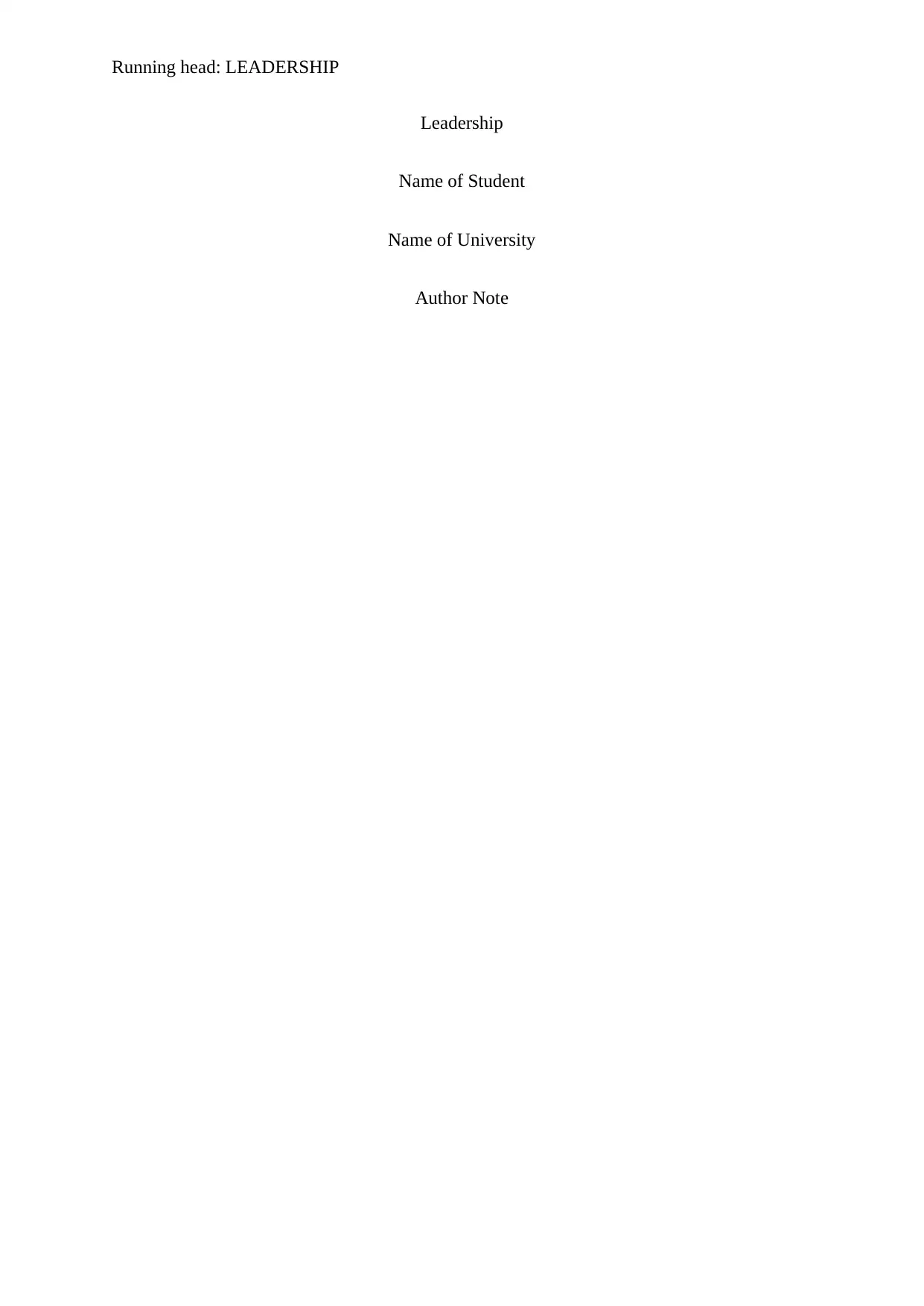
Running head: LEADERSHIP
Leadership
Name of Student
Name of University
Author Note
Leadership
Name of Student
Name of University
Author Note
Paraphrase This Document
Need a fresh take? Get an instant paraphrase of this document with our AI Paraphraser
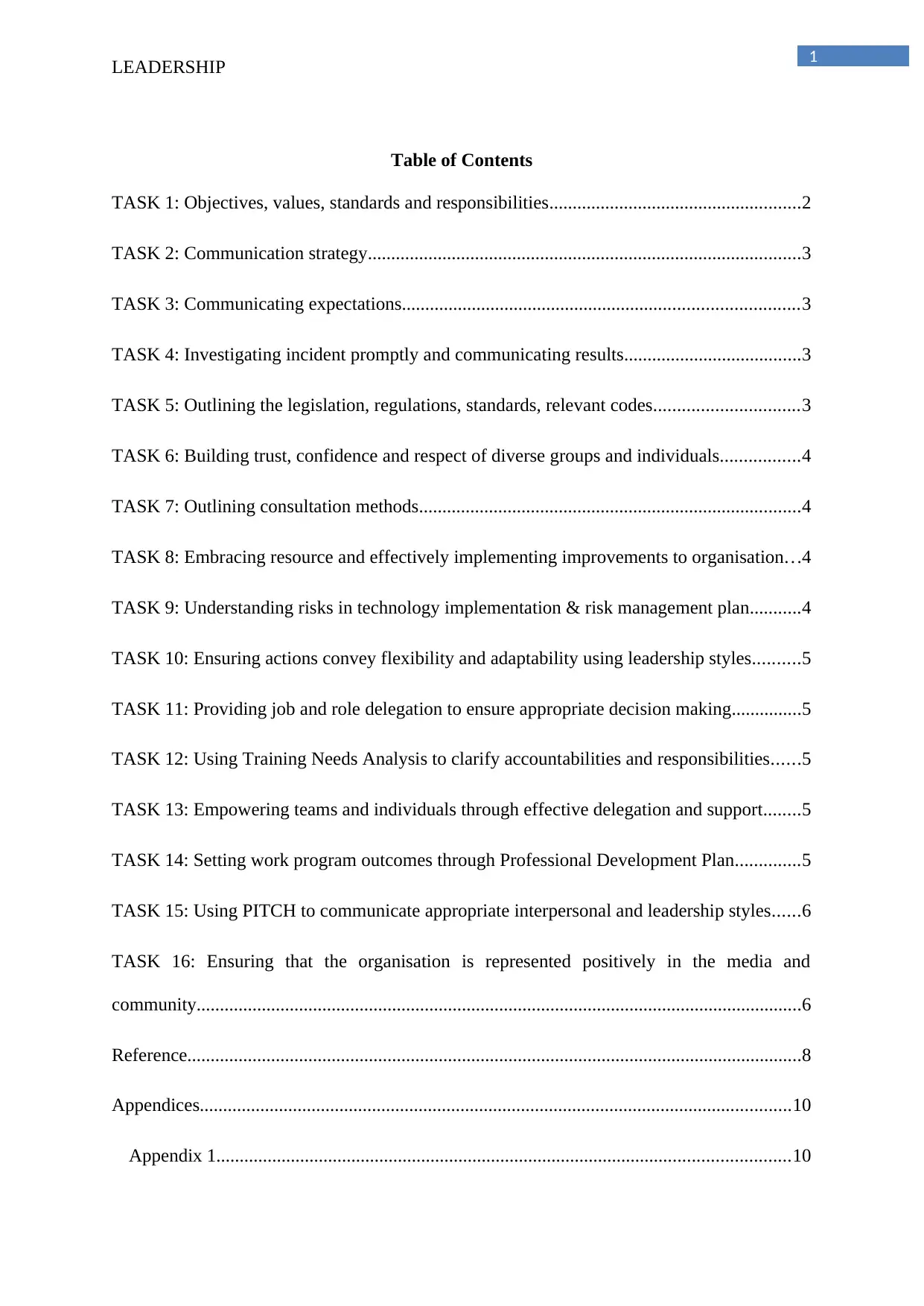
1
LEADERSHIP
Table of Contents
TASK 1: Objectives, values, standards and responsibilities......................................................2
TASK 2: Communication strategy.............................................................................................3
TASK 3: Communicating expectations.....................................................................................3
TASK 4: Investigating incident promptly and communicating results......................................3
TASK 5: Outlining the legislation, regulations, standards, relevant codes...............................3
TASK 6: Building trust, confidence and respect of diverse groups and individuals.................4
TASK 7: Outlining consultation methods..................................................................................4
TASK 8: Embracing resource and effectively implementing improvements to organisation...4
TASK 9: Understanding risks in technology implementation & risk management plan...........4
TASK 10: Ensuring actions convey flexibility and adaptability using leadership styles..........5
TASK 11: Providing job and role delegation to ensure appropriate decision making...............5
TASK 12: Using Training Needs Analysis to clarify accountabilities and responsibilities......5
TASK 13: Empowering teams and individuals through effective delegation and support........5
TASK 14: Setting work program outcomes through Professional Development Plan..............5
TASK 15: Using PITCH to communicate appropriate interpersonal and leadership styles......6
TASK 16: Ensuring that the organisation is represented positively in the media and
community..................................................................................................................................6
Reference....................................................................................................................................8
Appendices...............................................................................................................................10
Appendix 1...........................................................................................................................10
LEADERSHIP
Table of Contents
TASK 1: Objectives, values, standards and responsibilities......................................................2
TASK 2: Communication strategy.............................................................................................3
TASK 3: Communicating expectations.....................................................................................3
TASK 4: Investigating incident promptly and communicating results......................................3
TASK 5: Outlining the legislation, regulations, standards, relevant codes...............................3
TASK 6: Building trust, confidence and respect of diverse groups and individuals.................4
TASK 7: Outlining consultation methods..................................................................................4
TASK 8: Embracing resource and effectively implementing improvements to organisation...4
TASK 9: Understanding risks in technology implementation & risk management plan...........4
TASK 10: Ensuring actions convey flexibility and adaptability using leadership styles..........5
TASK 11: Providing job and role delegation to ensure appropriate decision making...............5
TASK 12: Using Training Needs Analysis to clarify accountabilities and responsibilities......5
TASK 13: Empowering teams and individuals through effective delegation and support........5
TASK 14: Setting work program outcomes through Professional Development Plan..............5
TASK 15: Using PITCH to communicate appropriate interpersonal and leadership styles......6
TASK 16: Ensuring that the organisation is represented positively in the media and
community..................................................................................................................................6
Reference....................................................................................................................................8
Appendices...............................................................................................................................10
Appendix 1...........................................................................................................................10
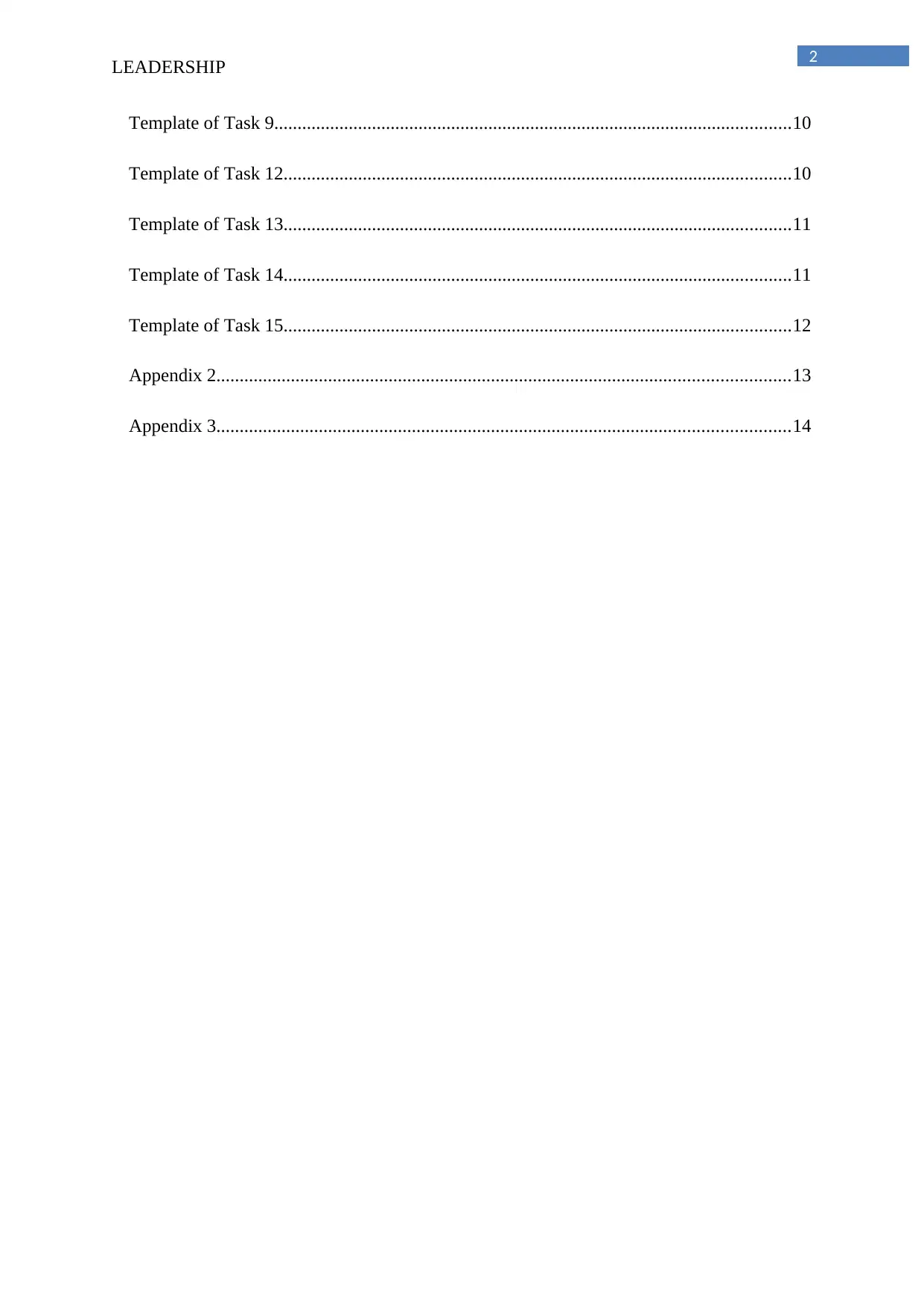
2
LEADERSHIP
Template of Task 9...............................................................................................................10
Template of Task 12.............................................................................................................10
Template of Task 13.............................................................................................................11
Template of Task 14.............................................................................................................11
Template of Task 15.............................................................................................................12
Appendix 2...........................................................................................................................13
Appendix 3...........................................................................................................................14
LEADERSHIP
Template of Task 9...............................................................................................................10
Template of Task 12.............................................................................................................10
Template of Task 13.............................................................................................................11
Template of Task 14.............................................................................................................11
Template of Task 15.............................................................................................................12
Appendix 2...........................................................................................................................13
Appendix 3...........................................................................................................................14
⊘ This is a preview!⊘
Do you want full access?
Subscribe today to unlock all pages.

Trusted by 1+ million students worldwide
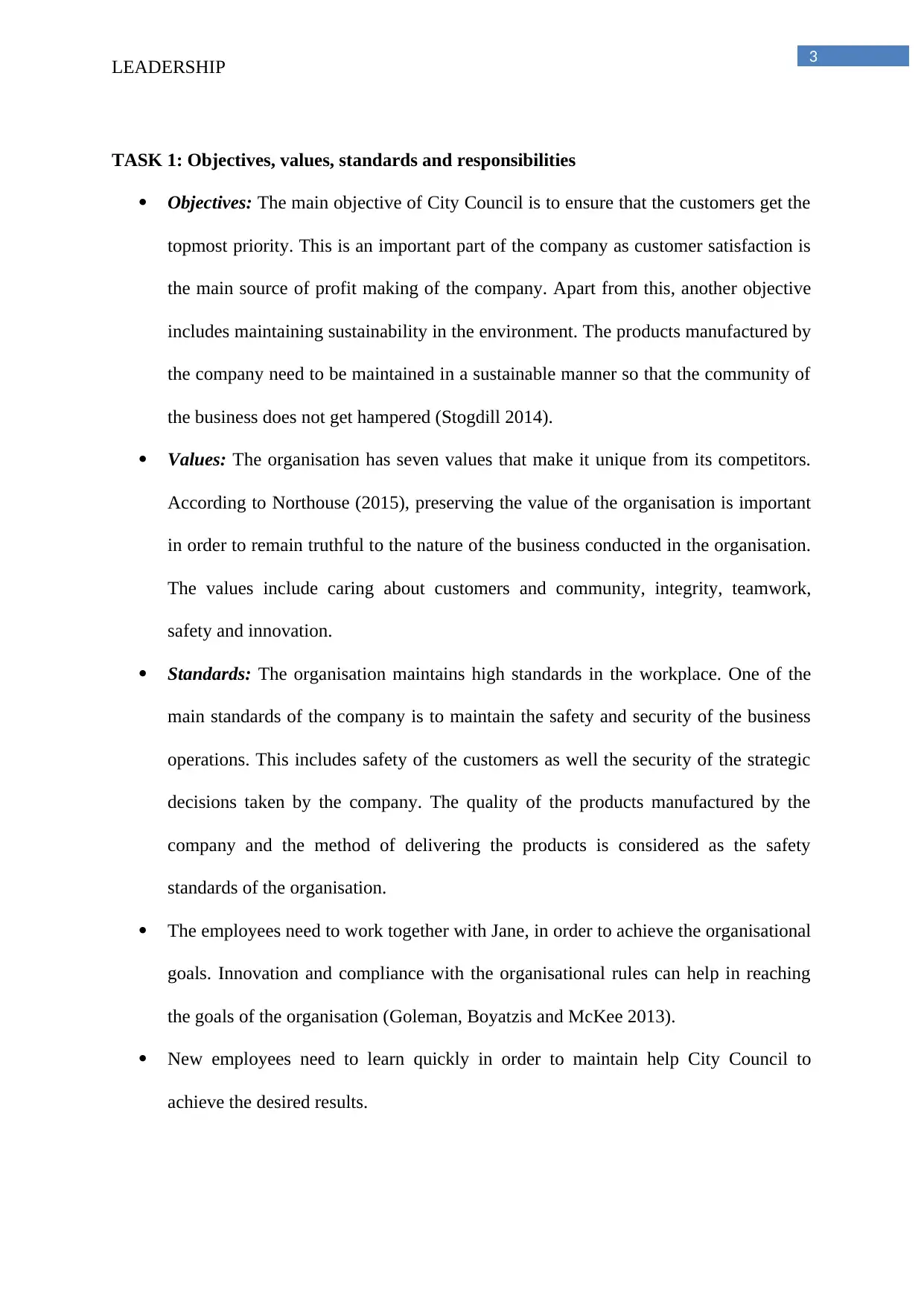
3
LEADERSHIP
TASK 1: Objectives, values, standards and responsibilities
Objectives: The main objective of City Council is to ensure that the customers get the
topmost priority. This is an important part of the company as customer satisfaction is
the main source of profit making of the company. Apart from this, another objective
includes maintaining sustainability in the environment. The products manufactured by
the company need to be maintained in a sustainable manner so that the community of
the business does not get hampered (Stogdill 2014).
Values: The organisation has seven values that make it unique from its competitors.
According to Northouse (2015), preserving the value of the organisation is important
in order to remain truthful to the nature of the business conducted in the organisation.
The values include caring about customers and community, integrity, teamwork,
safety and innovation.
Standards: The organisation maintains high standards in the workplace. One of the
main standards of the company is to maintain the safety and security of the business
operations. This includes safety of the customers as well the security of the strategic
decisions taken by the company. The quality of the products manufactured by the
company and the method of delivering the products is considered as the safety
standards of the organisation.
The employees need to work together with Jane, in order to achieve the organisational
goals. Innovation and compliance with the organisational rules can help in reaching
the goals of the organisation (Goleman, Boyatzis and McKee 2013).
New employees need to learn quickly in order to maintain help City Council to
achieve the desired results.
LEADERSHIP
TASK 1: Objectives, values, standards and responsibilities
Objectives: The main objective of City Council is to ensure that the customers get the
topmost priority. This is an important part of the company as customer satisfaction is
the main source of profit making of the company. Apart from this, another objective
includes maintaining sustainability in the environment. The products manufactured by
the company need to be maintained in a sustainable manner so that the community of
the business does not get hampered (Stogdill 2014).
Values: The organisation has seven values that make it unique from its competitors.
According to Northouse (2015), preserving the value of the organisation is important
in order to remain truthful to the nature of the business conducted in the organisation.
The values include caring about customers and community, integrity, teamwork,
safety and innovation.
Standards: The organisation maintains high standards in the workplace. One of the
main standards of the company is to maintain the safety and security of the business
operations. This includes safety of the customers as well the security of the strategic
decisions taken by the company. The quality of the products manufactured by the
company and the method of delivering the products is considered as the safety
standards of the organisation.
The employees need to work together with Jane, in order to achieve the organisational
goals. Innovation and compliance with the organisational rules can help in reaching
the goals of the organisation (Goleman, Boyatzis and McKee 2013).
New employees need to learn quickly in order to maintain help City Council to
achieve the desired results.
Paraphrase This Document
Need a fresh take? Get an instant paraphrase of this document with our AI Paraphraser
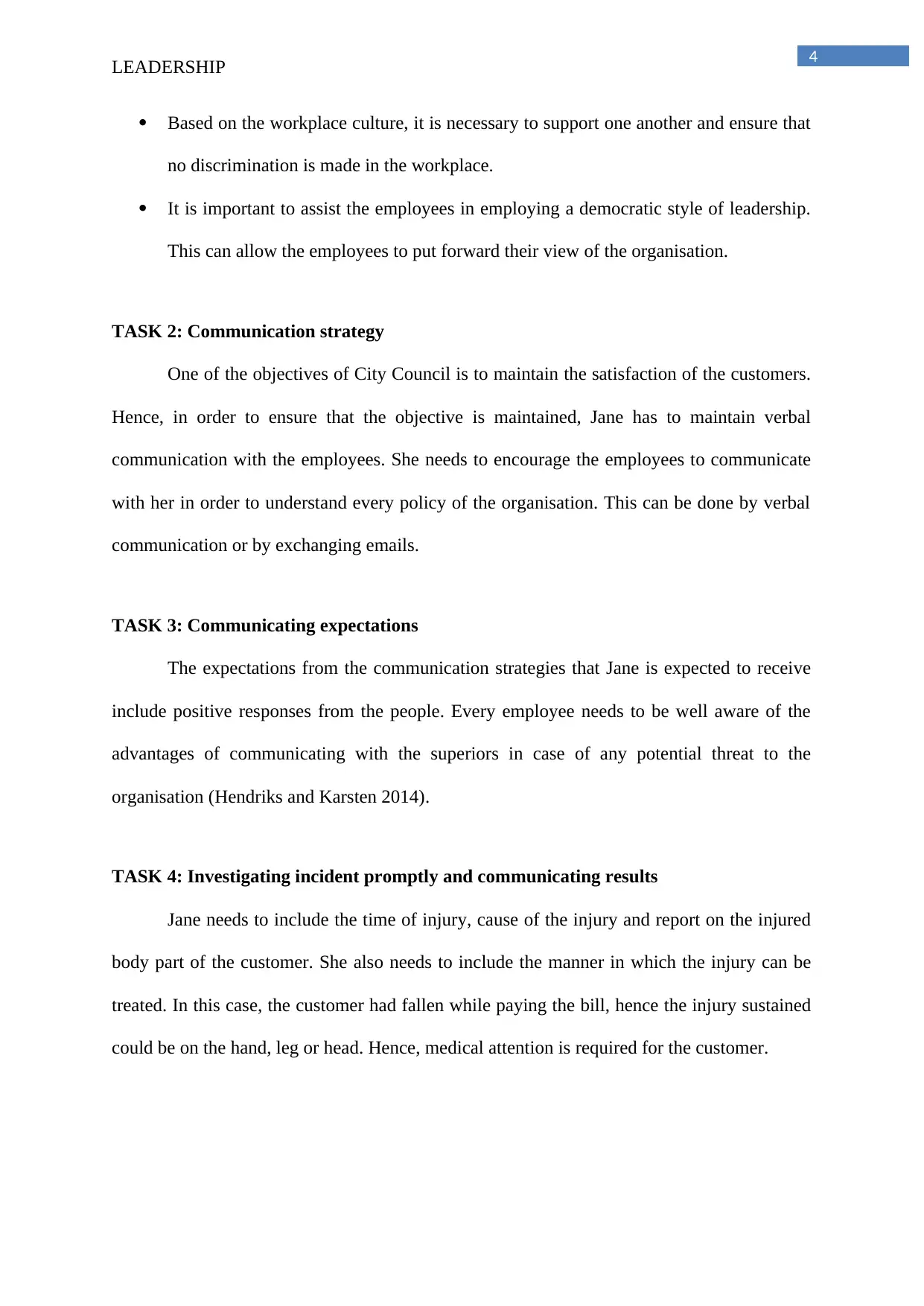
4
LEADERSHIP
Based on the workplace culture, it is necessary to support one another and ensure that
no discrimination is made in the workplace.
It is important to assist the employees in employing a democratic style of leadership.
This can allow the employees to put forward their view of the organisation.
TASK 2: Communication strategy
One of the objectives of City Council is to maintain the satisfaction of the customers.
Hence, in order to ensure that the objective is maintained, Jane has to maintain verbal
communication with the employees. She needs to encourage the employees to communicate
with her in order to understand every policy of the organisation. This can be done by verbal
communication or by exchanging emails.
TASK 3: Communicating expectations
The expectations from the communication strategies that Jane is expected to receive
include positive responses from the people. Every employee needs to be well aware of the
advantages of communicating with the superiors in case of any potential threat to the
organisation (Hendriks and Karsten 2014).
TASK 4: Investigating incident promptly and communicating results
Jane needs to include the time of injury, cause of the injury and report on the injured
body part of the customer. She also needs to include the manner in which the injury can be
treated. In this case, the customer had fallen while paying the bill, hence the injury sustained
could be on the hand, leg or head. Hence, medical attention is required for the customer.
LEADERSHIP
Based on the workplace culture, it is necessary to support one another and ensure that
no discrimination is made in the workplace.
It is important to assist the employees in employing a democratic style of leadership.
This can allow the employees to put forward their view of the organisation.
TASK 2: Communication strategy
One of the objectives of City Council is to maintain the satisfaction of the customers.
Hence, in order to ensure that the objective is maintained, Jane has to maintain verbal
communication with the employees. She needs to encourage the employees to communicate
with her in order to understand every policy of the organisation. This can be done by verbal
communication or by exchanging emails.
TASK 3: Communicating expectations
The expectations from the communication strategies that Jane is expected to receive
include positive responses from the people. Every employee needs to be well aware of the
advantages of communicating with the superiors in case of any potential threat to the
organisation (Hendriks and Karsten 2014).
TASK 4: Investigating incident promptly and communicating results
Jane needs to include the time of injury, cause of the injury and report on the injured
body part of the customer. She also needs to include the manner in which the injury can be
treated. In this case, the customer had fallen while paying the bill, hence the injury sustained
could be on the hand, leg or head. Hence, medical attention is required for the customer.
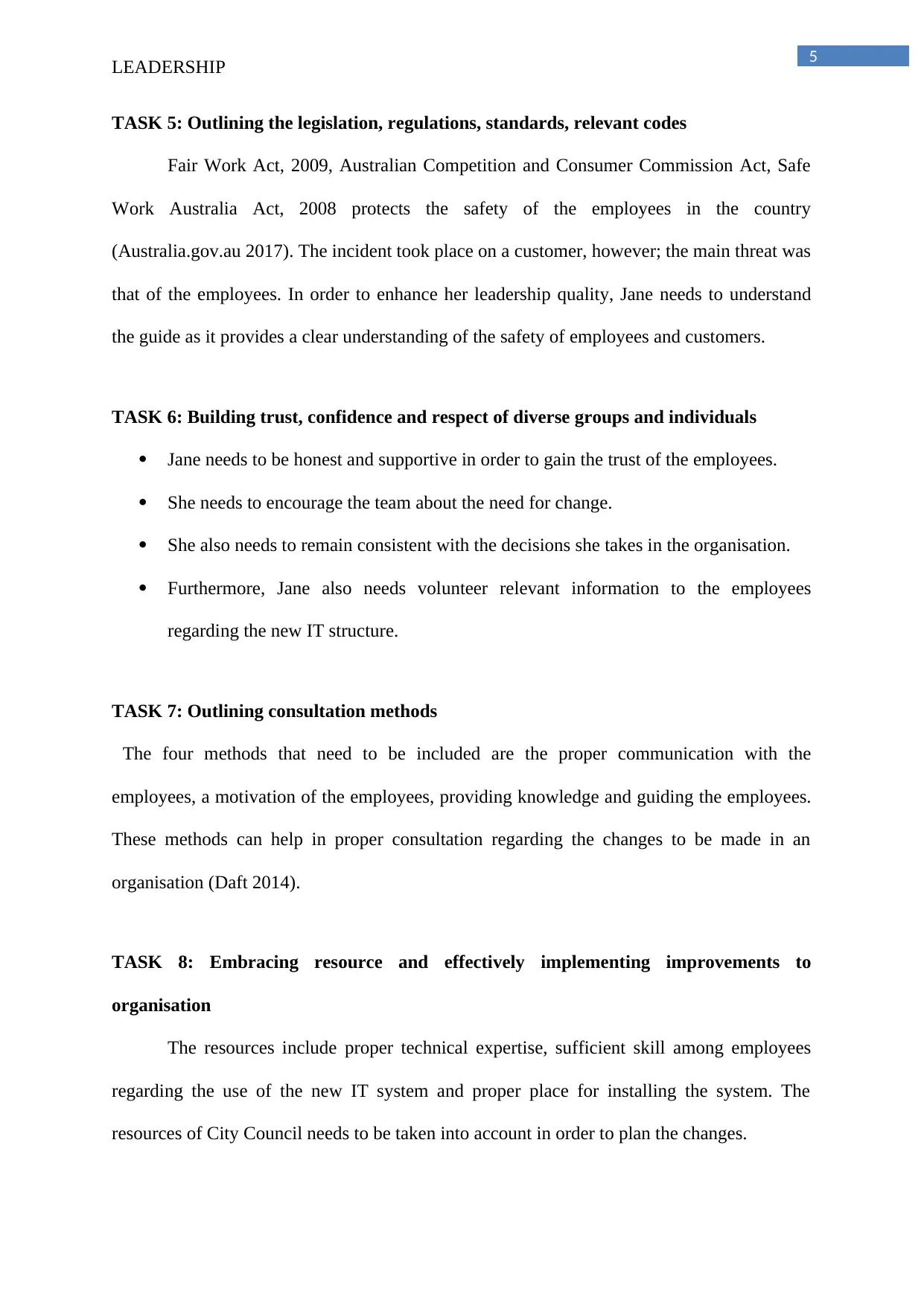
5
LEADERSHIP
TASK 5: Outlining the legislation, regulations, standards, relevant codes
Fair Work Act, 2009, Australian Competition and Consumer Commission Act, Safe
Work Australia Act, 2008 protects the safety of the employees in the country
(Australia.gov.au 2017). The incident took place on a customer, however; the main threat was
that of the employees. In order to enhance her leadership quality, Jane needs to understand
the guide as it provides a clear understanding of the safety of employees and customers.
TASK 6: Building trust, confidence and respect of diverse groups and individuals
Jane needs to be honest and supportive in order to gain the trust of the employees.
She needs to encourage the team about the need for change.
She also needs to remain consistent with the decisions she takes in the organisation.
Furthermore, Jane also needs volunteer relevant information to the employees
regarding the new IT structure.
TASK 7: Outlining consultation methods
The four methods that need to be included are the proper communication with the
employees, a motivation of the employees, providing knowledge and guiding the employees.
These methods can help in proper consultation regarding the changes to be made in an
organisation (Daft 2014).
TASK 8: Embracing resource and effectively implementing improvements to
organisation
The resources include proper technical expertise, sufficient skill among employees
regarding the use of the new IT system and proper place for installing the system. The
resources of City Council needs to be taken into account in order to plan the changes.
LEADERSHIP
TASK 5: Outlining the legislation, regulations, standards, relevant codes
Fair Work Act, 2009, Australian Competition and Consumer Commission Act, Safe
Work Australia Act, 2008 protects the safety of the employees in the country
(Australia.gov.au 2017). The incident took place on a customer, however; the main threat was
that of the employees. In order to enhance her leadership quality, Jane needs to understand
the guide as it provides a clear understanding of the safety of employees and customers.
TASK 6: Building trust, confidence and respect of diverse groups and individuals
Jane needs to be honest and supportive in order to gain the trust of the employees.
She needs to encourage the team about the need for change.
She also needs to remain consistent with the decisions she takes in the organisation.
Furthermore, Jane also needs volunteer relevant information to the employees
regarding the new IT structure.
TASK 7: Outlining consultation methods
The four methods that need to be included are the proper communication with the
employees, a motivation of the employees, providing knowledge and guiding the employees.
These methods can help in proper consultation regarding the changes to be made in an
organisation (Daft 2014).
TASK 8: Embracing resource and effectively implementing improvements to
organisation
The resources include proper technical expertise, sufficient skill among employees
regarding the use of the new IT system and proper place for installing the system. The
resources of City Council needs to be taken into account in order to plan the changes.
⊘ This is a preview!⊘
Do you want full access?
Subscribe today to unlock all pages.

Trusted by 1+ million students worldwide
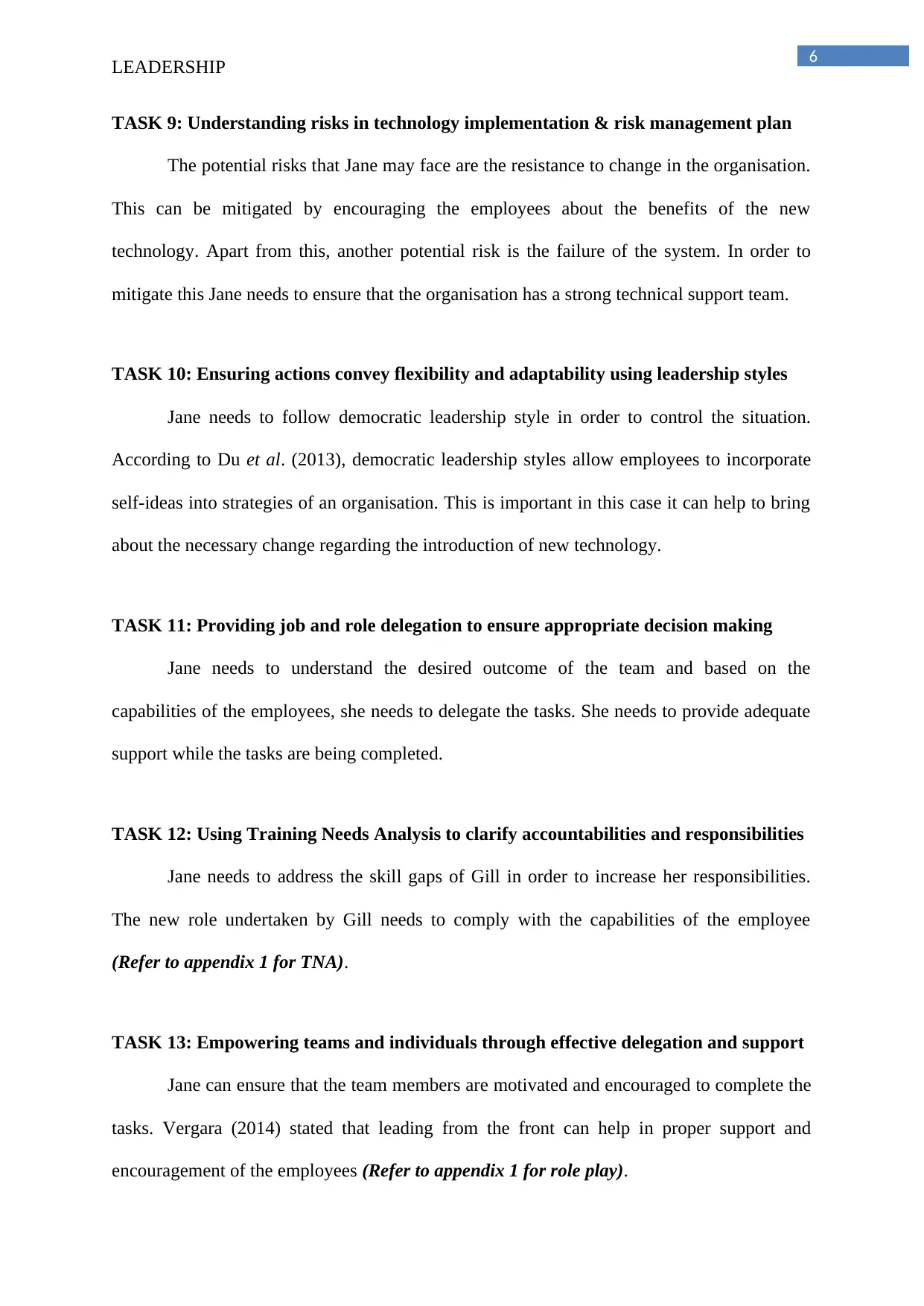
6
LEADERSHIP
TASK 9: Understanding risks in technology implementation & risk management plan
The potential risks that Jane may face are the resistance to change in the organisation.
This can be mitigated by encouraging the employees about the benefits of the new
technology. Apart from this, another potential risk is the failure of the system. In order to
mitigate this Jane needs to ensure that the organisation has a strong technical support team.
TASK 10: Ensuring actions convey flexibility and adaptability using leadership styles
Jane needs to follow democratic leadership style in order to control the situation.
According to Du et al. (2013), democratic leadership styles allow employees to incorporate
self-ideas into strategies of an organisation. This is important in this case it can help to bring
about the necessary change regarding the introduction of new technology.
TASK 11: Providing job and role delegation to ensure appropriate decision making
Jane needs to understand the desired outcome of the team and based on the
capabilities of the employees, she needs to delegate the tasks. She needs to provide adequate
support while the tasks are being completed.
TASK 12: Using Training Needs Analysis to clarify accountabilities and responsibilities
Jane needs to address the skill gaps of Gill in order to increase her responsibilities.
The new role undertaken by Gill needs to comply with the capabilities of the employee
(Refer to appendix 1 for TNA).
TASK 13: Empowering teams and individuals through effective delegation and support
Jane can ensure that the team members are motivated and encouraged to complete the
tasks. Vergara (2014) stated that leading from the front can help in proper support and
encouragement of the employees (Refer to appendix 1 for role play).
LEADERSHIP
TASK 9: Understanding risks in technology implementation & risk management plan
The potential risks that Jane may face are the resistance to change in the organisation.
This can be mitigated by encouraging the employees about the benefits of the new
technology. Apart from this, another potential risk is the failure of the system. In order to
mitigate this Jane needs to ensure that the organisation has a strong technical support team.
TASK 10: Ensuring actions convey flexibility and adaptability using leadership styles
Jane needs to follow democratic leadership style in order to control the situation.
According to Du et al. (2013), democratic leadership styles allow employees to incorporate
self-ideas into strategies of an organisation. This is important in this case it can help to bring
about the necessary change regarding the introduction of new technology.
TASK 11: Providing job and role delegation to ensure appropriate decision making
Jane needs to understand the desired outcome of the team and based on the
capabilities of the employees, she needs to delegate the tasks. She needs to provide adequate
support while the tasks are being completed.
TASK 12: Using Training Needs Analysis to clarify accountabilities and responsibilities
Jane needs to address the skill gaps of Gill in order to increase her responsibilities.
The new role undertaken by Gill needs to comply with the capabilities of the employee
(Refer to appendix 1 for TNA).
TASK 13: Empowering teams and individuals through effective delegation and support
Jane can ensure that the team members are motivated and encouraged to complete the
tasks. Vergara (2014) stated that leading from the front can help in proper support and
encouragement of the employees (Refer to appendix 1 for role play).
Paraphrase This Document
Need a fresh take? Get an instant paraphrase of this document with our AI Paraphraser
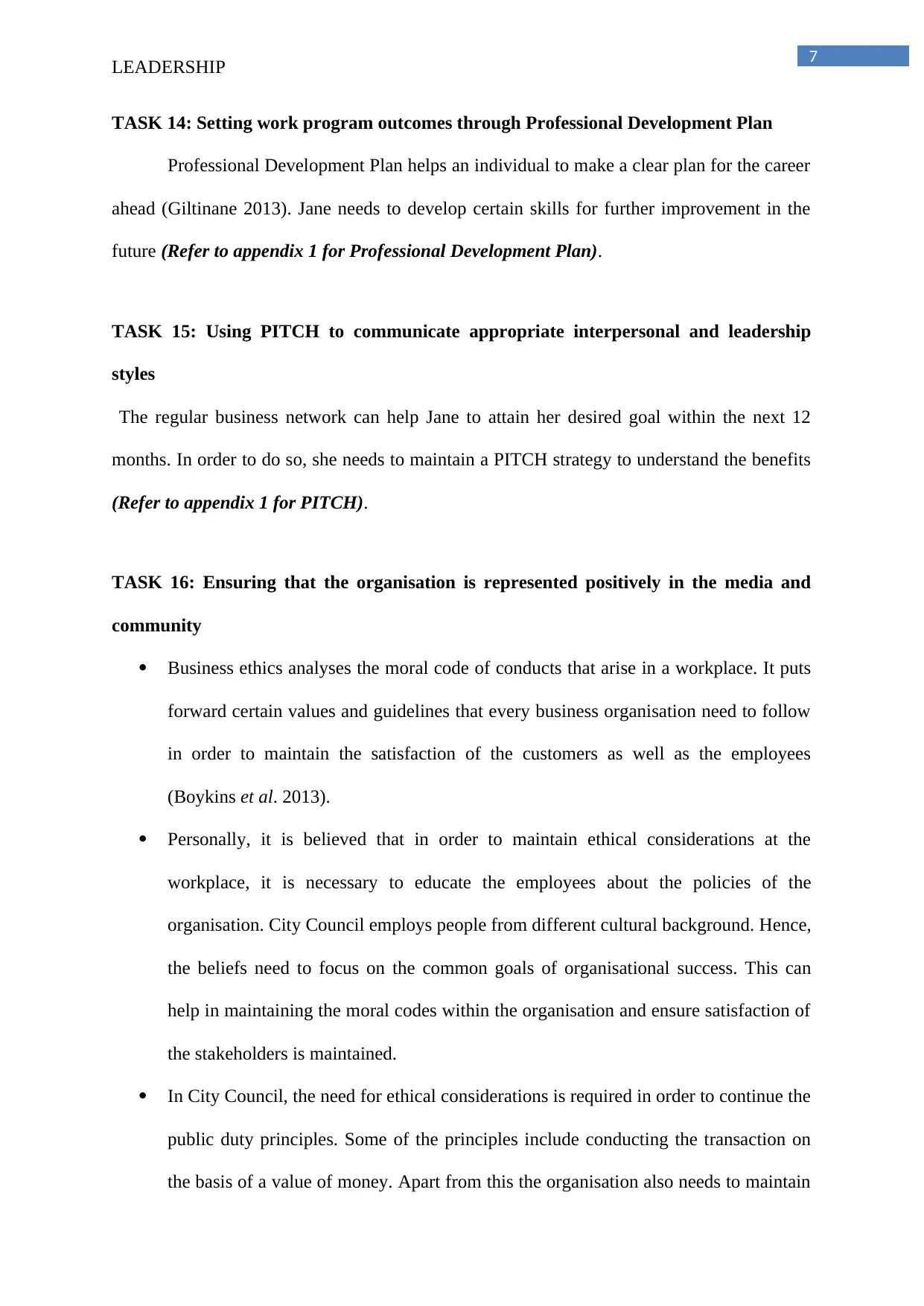
7
LEADERSHIP
TASK 14: Setting work program outcomes through Professional Development Plan
Professional Development Plan helps an individual to make a clear plan for the career
ahead (Giltinane 2013). Jane needs to develop certain skills for further improvement in the
future (Refer to appendix 1 for Professional Development Plan).
TASK 15: Using PITCH to communicate appropriate interpersonal and leadership
styles
The regular business network can help Jane to attain her desired goal within the next 12
months. In order to do so, she needs to maintain a PITCH strategy to understand the benefits
(Refer to appendix 1 for PITCH).
TASK 16: Ensuring that the organisation is represented positively in the media and
community
Business ethics analyses the moral code of conducts that arise in a workplace. It puts
forward certain values and guidelines that every business organisation need to follow
in order to maintain the satisfaction of the customers as well as the employees
(Boykins et al. 2013).
Personally, it is believed that in order to maintain ethical considerations at the
workplace, it is necessary to educate the employees about the policies of the
organisation. City Council employs people from different cultural background. Hence,
the beliefs need to focus on the common goals of organisational success. This can
help in maintaining the moral codes within the organisation and ensure satisfaction of
the stakeholders is maintained.
In City Council, the need for ethical considerations is required in order to continue the
public duty principles. Some of the principles include conducting the transaction on
the basis of a value of money. Apart from this the organisation also needs to maintain
LEADERSHIP
TASK 14: Setting work program outcomes through Professional Development Plan
Professional Development Plan helps an individual to make a clear plan for the career
ahead (Giltinane 2013). Jane needs to develop certain skills for further improvement in the
future (Refer to appendix 1 for Professional Development Plan).
TASK 15: Using PITCH to communicate appropriate interpersonal and leadership
styles
The regular business network can help Jane to attain her desired goal within the next 12
months. In order to do so, she needs to maintain a PITCH strategy to understand the benefits
(Refer to appendix 1 for PITCH).
TASK 16: Ensuring that the organisation is represented positively in the media and
community
Business ethics analyses the moral code of conducts that arise in a workplace. It puts
forward certain values and guidelines that every business organisation need to follow
in order to maintain the satisfaction of the customers as well as the employees
(Boykins et al. 2013).
Personally, it is believed that in order to maintain ethical considerations at the
workplace, it is necessary to educate the employees about the policies of the
organisation. City Council employs people from different cultural background. Hence,
the beliefs need to focus on the common goals of organisational success. This can
help in maintaining the moral codes within the organisation and ensure satisfaction of
the stakeholders is maintained.
In City Council, the need for ethical considerations is required in order to continue the
public duty principles. Some of the principles include conducting the transaction on
the basis of a value of money. Apart from this the organisation also needs to maintain
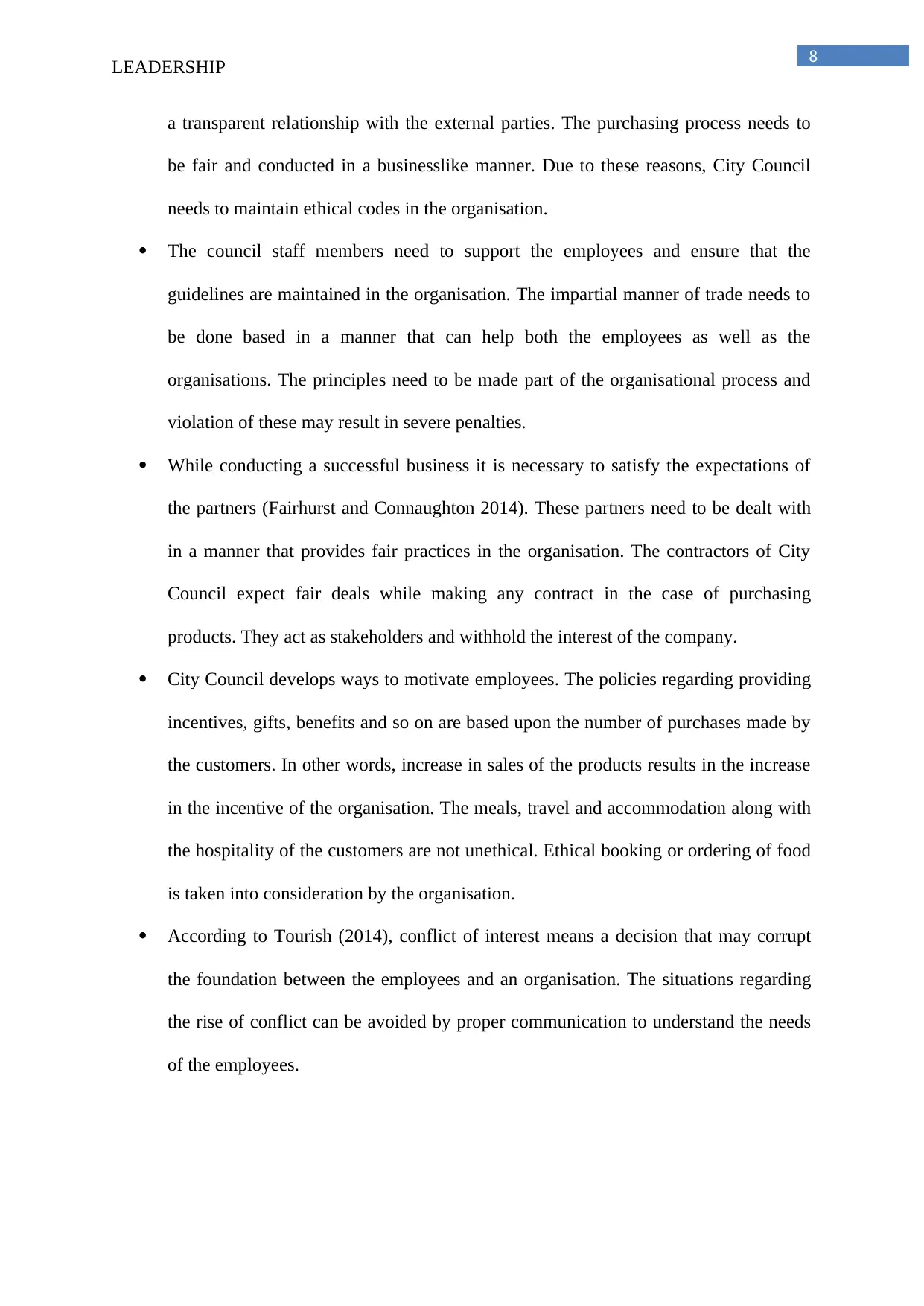
8
LEADERSHIP
a transparent relationship with the external parties. The purchasing process needs to
be fair and conducted in a businesslike manner. Due to these reasons, City Council
needs to maintain ethical codes in the organisation.
The council staff members need to support the employees and ensure that the
guidelines are maintained in the organisation. The impartial manner of trade needs to
be done based in a manner that can help both the employees as well as the
organisations. The principles need to be made part of the organisational process and
violation of these may result in severe penalties.
While conducting a successful business it is necessary to satisfy the expectations of
the partners (Fairhurst and Connaughton 2014). These partners need to be dealt with
in a manner that provides fair practices in the organisation. The contractors of City
Council expect fair deals while making any contract in the case of purchasing
products. They act as stakeholders and withhold the interest of the company.
City Council develops ways to motivate employees. The policies regarding providing
incentives, gifts, benefits and so on are based upon the number of purchases made by
the customers. In other words, increase in sales of the products results in the increase
in the incentive of the organisation. The meals, travel and accommodation along with
the hospitality of the customers are not unethical. Ethical booking or ordering of food
is taken into consideration by the organisation.
According to Tourish (2014), conflict of interest means a decision that may corrupt
the foundation between the employees and an organisation. The situations regarding
the rise of conflict can be avoided by proper communication to understand the needs
of the employees.
LEADERSHIP
a transparent relationship with the external parties. The purchasing process needs to
be fair and conducted in a businesslike manner. Due to these reasons, City Council
needs to maintain ethical codes in the organisation.
The council staff members need to support the employees and ensure that the
guidelines are maintained in the organisation. The impartial manner of trade needs to
be done based in a manner that can help both the employees as well as the
organisations. The principles need to be made part of the organisational process and
violation of these may result in severe penalties.
While conducting a successful business it is necessary to satisfy the expectations of
the partners (Fairhurst and Connaughton 2014). These partners need to be dealt with
in a manner that provides fair practices in the organisation. The contractors of City
Council expect fair deals while making any contract in the case of purchasing
products. They act as stakeholders and withhold the interest of the company.
City Council develops ways to motivate employees. The policies regarding providing
incentives, gifts, benefits and so on are based upon the number of purchases made by
the customers. In other words, increase in sales of the products results in the increase
in the incentive of the organisation. The meals, travel and accommodation along with
the hospitality of the customers are not unethical. Ethical booking or ordering of food
is taken into consideration by the organisation.
According to Tourish (2014), conflict of interest means a decision that may corrupt
the foundation between the employees and an organisation. The situations regarding
the rise of conflict can be avoided by proper communication to understand the needs
of the employees.
⊘ This is a preview!⊘
Do you want full access?
Subscribe today to unlock all pages.

Trusted by 1+ million students worldwide
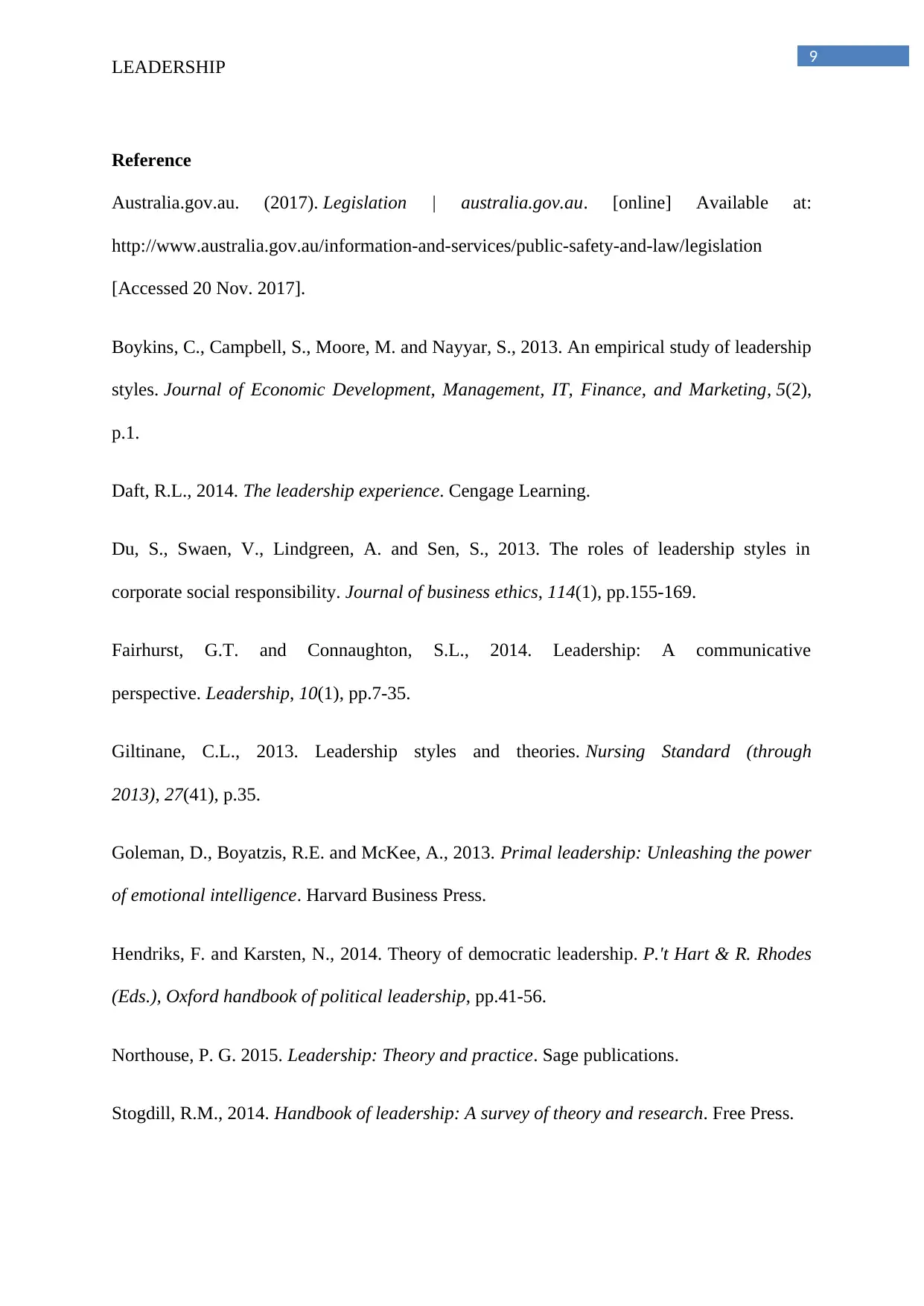
9
LEADERSHIP
Reference
Australia.gov.au. (2017). Legislation | australia.gov.au. [online] Available at:
http://www.australia.gov.au/information-and-services/public-safety-and-law/legislation
[Accessed 20 Nov. 2017].
Boykins, C., Campbell, S., Moore, M. and Nayyar, S., 2013. An empirical study of leadership
styles. Journal of Economic Development, Management, IT, Finance, and Marketing, 5(2),
p.1.
Daft, R.L., 2014. The leadership experience. Cengage Learning.
Du, S., Swaen, V., Lindgreen, A. and Sen, S., 2013. The roles of leadership styles in
corporate social responsibility. Journal of business ethics, 114(1), pp.155-169.
Fairhurst, G.T. and Connaughton, S.L., 2014. Leadership: A communicative
perspective. Leadership, 10(1), pp.7-35.
Giltinane, C.L., 2013. Leadership styles and theories. Nursing Standard (through
2013), 27(41), p.35.
Goleman, D., Boyatzis, R.E. and McKee, A., 2013. Primal leadership: Unleashing the power
of emotional intelligence. Harvard Business Press.
Hendriks, F. and Karsten, N., 2014. Theory of democratic leadership. P.'t Hart & R. Rhodes
(Eds.), Oxford handbook of political leadership, pp.41-56.
Northouse, P. G. 2015. Leadership: Theory and practice. Sage publications.
Stogdill, R.M., 2014. Handbook of leadership: A survey of theory and research. Free Press.
LEADERSHIP
Reference
Australia.gov.au. (2017). Legislation | australia.gov.au. [online] Available at:
http://www.australia.gov.au/information-and-services/public-safety-and-law/legislation
[Accessed 20 Nov. 2017].
Boykins, C., Campbell, S., Moore, M. and Nayyar, S., 2013. An empirical study of leadership
styles. Journal of Economic Development, Management, IT, Finance, and Marketing, 5(2),
p.1.
Daft, R.L., 2014. The leadership experience. Cengage Learning.
Du, S., Swaen, V., Lindgreen, A. and Sen, S., 2013. The roles of leadership styles in
corporate social responsibility. Journal of business ethics, 114(1), pp.155-169.
Fairhurst, G.T. and Connaughton, S.L., 2014. Leadership: A communicative
perspective. Leadership, 10(1), pp.7-35.
Giltinane, C.L., 2013. Leadership styles and theories. Nursing Standard (through
2013), 27(41), p.35.
Goleman, D., Boyatzis, R.E. and McKee, A., 2013. Primal leadership: Unleashing the power
of emotional intelligence. Harvard Business Press.
Hendriks, F. and Karsten, N., 2014. Theory of democratic leadership. P.'t Hart & R. Rhodes
(Eds.), Oxford handbook of political leadership, pp.41-56.
Northouse, P. G. 2015. Leadership: Theory and practice. Sage publications.
Stogdill, R.M., 2014. Handbook of leadership: A survey of theory and research. Free Press.
Paraphrase This Document
Need a fresh take? Get an instant paraphrase of this document with our AI Paraphraser
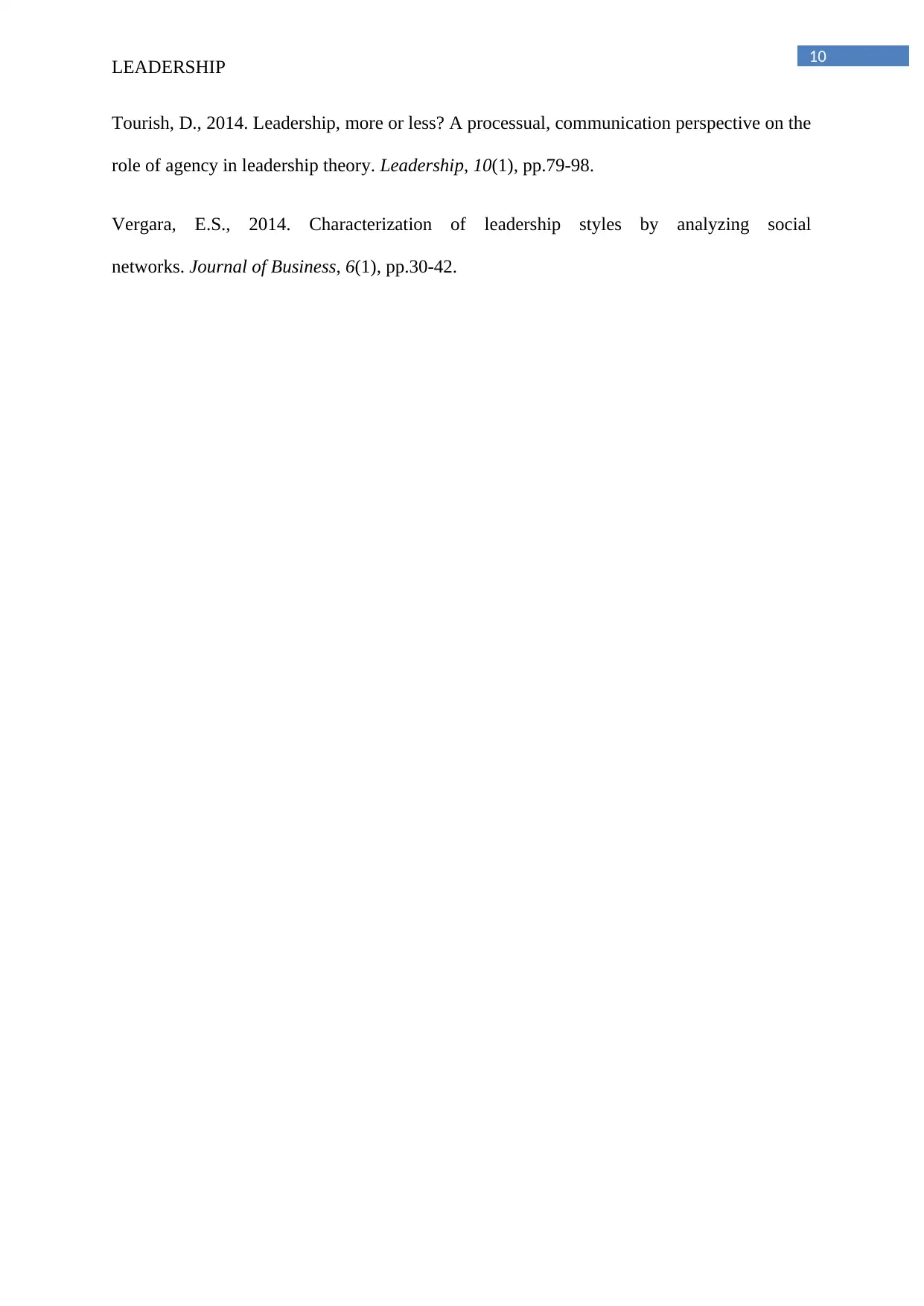
10
LEADERSHIP
Tourish, D., 2014. Leadership, more or less? A processual, communication perspective on the
role of agency in leadership theory. Leadership, 10(1), pp.79-98.
Vergara, E.S., 2014. Characterization of leadership styles by analyzing social
networks. Journal of Business, 6(1), pp.30-42.
LEADERSHIP
Tourish, D., 2014. Leadership, more or less? A processual, communication perspective on the
role of agency in leadership theory. Leadership, 10(1), pp.79-98.
Vergara, E.S., 2014. Characterization of leadership styles by analyzing social
networks. Journal of Business, 6(1), pp.30-42.
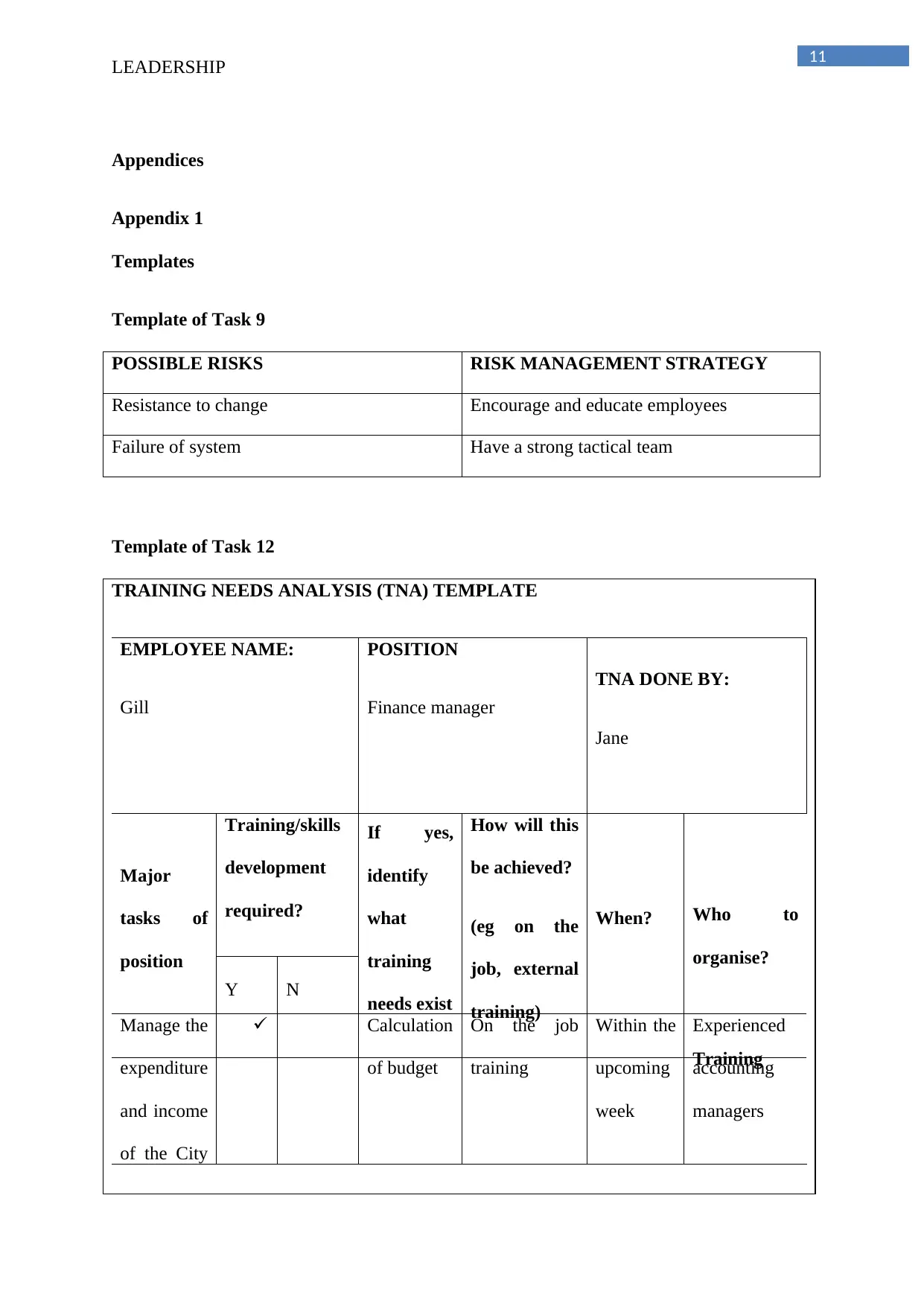
11
LEADERSHIP
Appendices
Appendix 1
Templates
Template of Task 9
POSSIBLE RISKS RISK MANAGEMENT STRATEGY
Resistance to change Encourage and educate employees
Failure of system Have a strong tactical team
Template of Task 12
TRAINING NEEDS ANALYSIS (TNA) TEMPLATE
EMPLOYEE NAME:
Gill
POSITION
Finance manager
TNA DONE BY:
Jane
Major
tasks of
position
Training/skills
development
required?
If yes,
identify
what
training
needs exist
How will this
be achieved?
(eg on the
job, external
training)
When? Who to
organise?
Training
Y N
Manage the
expenditure
and income
of the City
Calculation
of budget
On the job
training
Within the
upcoming
week
Experienced
accounting
managers
LEADERSHIP
Appendices
Appendix 1
Templates
Template of Task 9
POSSIBLE RISKS RISK MANAGEMENT STRATEGY
Resistance to change Encourage and educate employees
Failure of system Have a strong tactical team
Template of Task 12
TRAINING NEEDS ANALYSIS (TNA) TEMPLATE
EMPLOYEE NAME:
Gill
POSITION
Finance manager
TNA DONE BY:
Jane
Major
tasks of
position
Training/skills
development
required?
If yes,
identify
what
training
needs exist
How will this
be achieved?
(eg on the
job, external
training)
When? Who to
organise?
Training
Y N
Manage the
expenditure
and income
of the City
Calculation
of budget
On the job
training
Within the
upcoming
week
Experienced
accounting
managers
⊘ This is a preview!⊘
Do you want full access?
Subscribe today to unlock all pages.

Trusted by 1+ million students worldwide
1 out of 17
Related Documents
Your All-in-One AI-Powered Toolkit for Academic Success.
+13062052269
info@desklib.com
Available 24*7 on WhatsApp / Email
![[object Object]](/_next/static/media/star-bottom.7253800d.svg)
Unlock your academic potential
Copyright © 2020–2025 A2Z Services. All Rights Reserved. Developed and managed by ZUCOL.





